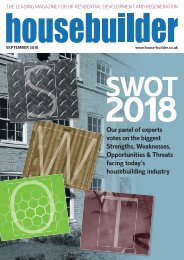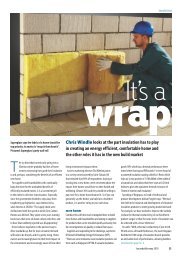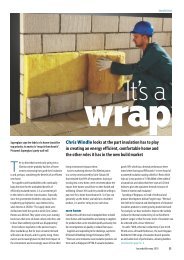Housebuilder October 2018
Create successful ePaper yourself
Turn your PDF publications into a flip-book with our unique Google optimized e-Paper software.
THE<br />
INTERVIEW Stephen Teagle, Galliford Try Partnerships<br />
Diversity<br />
To achieve sustained growth at pace, Galliford Try<br />
Partnerships is seeking to recruit widely, not just<br />
on site but in offices, and across a diverse pool,<br />
says Stephen Teagle. “We’re looking at the barriers<br />
to people coming in and we support graduates<br />
and mentor people,” he says. The business offers<br />
apprenticeships and trainee programmes in trade,<br />
construction and business support.<br />
“Something we absolutely must do is increase<br />
the proportion of women in the sector,” Teagle<br />
continues. “We have to make the case for the<br />
industry. Having a more balanced housebuilding<br />
model will be a strong attraction.”<br />
The 479 homes in Ferry Lane, north London, will<br />
all be wholly owned and managed as PRS units<br />
Continued from page 18<br />
With the latter it is delivering a purely private rented<br />
development at the Ferry Lane site in north London.<br />
(For more on this scheme and others, see box on page<br />
17). There is much scope for PRS, Teagle states. “There<br />
is an absolute opportunity to increase PRS delivery.<br />
Sigma is working with others. There’s a range of PRS<br />
providers that aren’t just focused on urban sites near<br />
transport modes. There’s also an opportunity for low<br />
rise PRS. It’s a sector that’s moved on from its infancy.”<br />
With the company’s mixed tenure sensibilities,<br />
Teagle must be pleased with the recently published<br />
Letwin review. This advocates a greater range of<br />
house types and tenures on large sites to improve<br />
build out rates. “There are three positive things about<br />
the Letwin review. Letwin understands the industry<br />
and the business model. Secondly he has dealt<br />
with discussions surrounding landbanking. It’s an<br />
input cost; what we’re about is getting the land and<br />
converting it to homes quickly. And – he understands<br />
that in order to address increases in output, you must<br />
deal with absorption. I see the review as a positive<br />
contribution to the industry.”<br />
Continued on page 22 4<br />
housebuilder october <strong>2018</strong> 21







